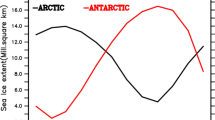Abstract
Emphasizing the model’s ability in mean climate reproduction in high northern latitudes, results from an ocean-sea ice-atmosphere coupled model are analyzed. It is shown that the coupled model can simulate the main characteristics of annual mean global sea surface temperature and sea level pressure well, but the extent of ice coverage produced in the Southern Hemisphere is not large enough. The main distribution characteristics of simulated sea level pressure and temperature at 850 hPa in high northern latitudes agree well with their counterparts in the NCEP reanalysis dataset, and the model can reproduce the Arctic Oscillation (AO) mode successfully. The simulated seasonal variation of sea ice in the Northern Hemisphere is rational and its main distribution features in winter agree well with those from observations. But the ice concentration in the sea ice edge area close to the Eurasian continent in the inner Arctic Ocean is much larger than the observation. There are significant interannual variation signals in the simulated sea ice concentration in winter in high northern latitudes and the most significant area lies in the Greenland Sea, followed by the Barents Sea. All of these features agree well with the results from observations.
Similar content being viewed by others
References
Grotzner, A., R. Sausen, and M. Claussen, 1996: The impact of sub-grid scale sea-ice inhomogeneities on the performance of the atmospheric general circulation model ECHAM.Climate Dyn.,12, 477–496.
Jin Xiangze, Zhang Xuehong, and Zhou Tianjun, 1999: Fundamental framework and experiments of the third generation of IAP/LASG world ocean general circulation model.Adv. Atmos. Sci.,16(2), 197–215.
Levitus, S., T. P. Boyer, 1994:World Ocean Atlas 1994: Temperature and Salinity. U. S. Department of Commerce, Washington D. C.
Liu Qinzheng, Huang Jiayou, Bai Shan, and Wu Huiding, 2000: Simulated sea ice in a global ice-sea coupled model.Earth Science Frontiers, 7(Suppl.), 219–228. (in Chinese)
Liu Xiying, 2001: Simulation of sea-sea ice-air interaction in high northern latitudes. Ph. D. dissertation, Institute of Atmospheric Physics, Chinese Academy of Sciences. (in Chinese)
Messinger, F., and Z. I. Janjic, 1985: Problems and numerical methods of the incorporation of mountains in atmospheric models.Lectures in Applied Mathematics,22, 81–120.
Parkinson, C. L., and W. M. Washington, 1979: A largescale numerical model of sea ice.J. Geophys. Res.,84, 311–337.
Phillips, T., 2002: Summary documentation: CMIP model features and experimental implementation. [Availble on line from http://wwwpcmdi.llnl.gov/modeldoc/cmip/index.html.]
Semtner, Jr. A. J., 1976: A model for the thermodynamic growth of sea ice in numerical investigations of climate.J. Geophys. Res.,6, 379–389.
Stockdale, T. N., A. J. Busalacchi, D. E. Harrison, and R. Seager, 1998: Ocean modeling for ENSO.J. Geophys, Res.,103, 14325–14355.
Thompson, D. W. J., and J. M. Wallace, 1998: The Arctic Oscillation signature in the wintertime geopotential height and temperature fields.Geophys. Res. Lett. 25, 1297–1300.
Wu Guoxiong, and Coauthors, 1997: Global oceanatmosphere-land system model of LASG (GOALS / LASG) and its performance in simulation study.Quart. J. Appl. Meteor., 8(Suppl.), 15–28. (in Chinese)
Ye Zhengqing, Dong Min, and Chen Jiabin, 2000: Climate simulated under observed sea surface temperature with an AGCM from National Climate Center.Study and Design of Operational Dynamic Model for Short Range Climate Prediction, China Meteorological Press, Beijing, 70–78. (in Chinese)
Yu Rucong, 1989: Design of the limited area numerical weather prediction model with steep mountains.Chinese J. Atmos. Sci.,13(2), 145–158. (in Chinese)
Yu Yongqiang, Yu Rucong, Zhang Xuehong, and Liu Hailong, 2002: A Flexible Global Coupled Climate Model.Adv. Atmos. Sci.,19, 169–190.
Yu Yongqiang, Zhang Xuehong, Liu Hui, and Jin Xiangze, 2000: Schemes for coupling AGCM and OGCM.IAP Globalx Ocean-Atmosphere-Land System Model, Zhang Xuehong et al., Eds., Science Press, Beijing, 100–114.
Zhang, X.-H., K.-M. Chen, X.-Z. Jin, W.-Y. Lin, and Y.-Q. Yu, 1996: Simulation of the thermohaline circulation with a twenty-layer oceanic general circulatoin model.Theoretical and Applied Climatology,55, 65–87.
Zhang Xuehong, Yu Yongqiang, Yu Rucong, Liu Hailong, Zhou Tianjun, and Li Wei, 2003: Evaluation on an ocean general circulation model and the corresponding ocean-atmosphere coupled model. Part 1: Annual mean simulations in the tropical pacific ocean.Chinese Journal of Atmospheric Sciences,27(6), 949–967. (in Chinese)
Author information
Authors and Affiliations
Corresponding author
Rights and permissions
About this article
Cite this article
Liu, X., Zhang, X., Yu, Y. et al. Mean climatic characteristics in high northern latitudes in an ocean-sea ice-atmosphere coupled model. Adv. Atmos. Sci. 21, 236–244 (2004). https://doi.org/10.1007/BF02915710
Received:
Revised:
Issue Date:
DOI: https://doi.org/10.1007/BF02915710



